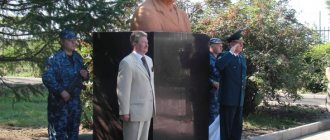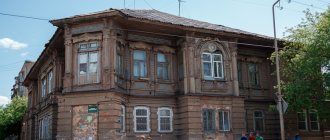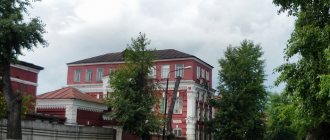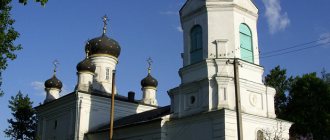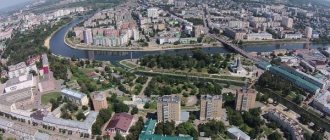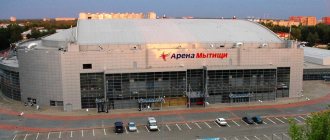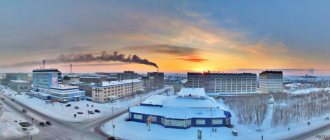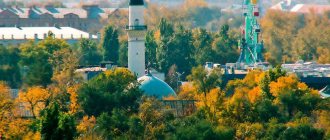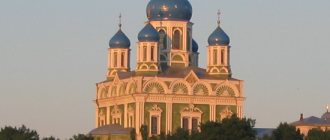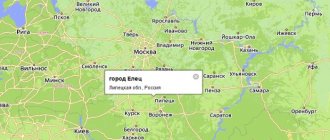This term has other meanings, see Gagarin (meanings).
| City | |
| Gagarin | |
| Flag | Coat of arms |
Moscow
Smolensk
Gagarin
Gagarin
Media files on Wikimedia CommonsGagarin
(until 1968
Gzhatsk
[2]) is a city in the Smolensk region of Russia. The administrative center of the Gagarinsky district and the Gagarinsky urban settlement included in it.
The area of the city is 14.46 km², the population is 28,702[1] people. (2021).
The city is located on the Gzhat River (Volga basin) in the southern part of the Gzhat-Vazuz lowland, 180 km southwest of Moscow and 239 km northeast of Smolensk.
Content
- 1 Geographical location
- 2 City coat of arms
- 3 History 3.1 Years of the Great Patriotic War
- 3.2 Renaming
- 3.3 Modern period (since 1992)
- 6.1 Automotive
THE FINAL MEETING OF THE CITY COUNCIL OF DEPUTIES WAS HELD IN THE OUTGOING YEAR
On December 23, 2022, the final meeting of the city Council of Deputies of the outgoing year was held under the chairmanship of the City Head Natalya Chentsova.
Read more "
Date: 12/28/2020
Geographical position
The city is located on flat terrain in the valley of the Gzhat River, a tributary of the Vazuza.
| Distance from Gagarin to major cities (by road)[3]: | |||||||||
| Rzhev ~ 110 km Sychevka ~ 96 km | Torzhok ~ 284 km Staritsa ~ 206 km | Tver ~ 200 km Volokolamsk ~ 130 | |||||||
| Vitebsk ~ 340 km | Mozhaisk ~ 77 km Moscow (MKAD) ~ 179 km | ||||||||
| Vyazma ~ 65 km Smolensk ~ 233 km | Yukhnov ~ 168 km | Obninsk ~ 152 km Kaluga ~ 221 km | |||||||
House of Yuri Gagarin in the village of Klushino
Local residents are very proud that the first Soviet cosmonaut to conquer space came from Gzhatsk. All streets, squares, museums, monuments are dedicated to Yuri Gagarin, his family and unforgettable feat. It was with the aim of perpetuating his name that the house in the village of Klushino was preserved.
History turned out to be such that it was in this house that the little boy Yura was born. The Gagarin family lived here during the occupation. More precisely, in a small dugout near the house. According to tradition, before a flight, Russian cosmonauts come to Klushino to drink water from a well near their house. This is considered a blessing from Gagarin himself.
Story
Gzhatsk was renamed Gagarin on April 23, 1968.
The name of the city comes from the hydronym Gzhat of Baltic origin, from gùžas
'stork'[4].
In 1703, on the orders of Peter I, it was founded as a pier on the Gzhat River (called Gzhatskaya pier)[5].
Year 1703... Finally, after everything was corrected, the Great Sovereign returned to Moscow; and in the same year, under the constant care of His Majesty, an arms and foundry factory was built in Sestrebek, and a pier on the Gzhati River, from which it would be convenient to load barges heading to St. Petersburg, which in the same year the Monarch populated with wealthy merchants, having transferred them from Mozhaisk , Vereya, Borovsk, Kaluga and other cities close to it.
In 1719, the first caravan of barges delivered food to St. Petersburg. Since then, Peter I ordered that the Gzhatskaya pier be considered the granary of St. Petersburg[6]. From the middle of the 18th century - Gzhatskaya Sloboda; in 1776, by decree of Catherine II, it was transformed into the district city of Gzhatsk [7] and received a coat of arms: “a barge loaded with grain and ready for departure in a silver field as a sign that there is a glorious grain pier near this city.”
The city was formed at the intersection of water and land routes - Moscow (from east to west) and Smolensk (from the south parallel to the river). According to the regular plan of 1773, it took the shape of a triangle, one side of which was extended parallel to the Gzhat River, the other parallel to the road to Moscow, the base of the triangle connected both sides. The city was surrounded by a rampart, inside which the streets were located in a rectangular grid. Not far from Gzhatsk in the village of Tsarevo-Zaymishche on August 29, 1812, M. I. Kutuzov took command of the Russian army. On the day the Napoleonic army entered, the city caught fire at night and burned for several days. A partisan detachment of Denis Davydov began operating near Gzhatsk. The Russian army re-entered the city on November 2, 1812. When the city was restored in 1817, the previous regular layout was largely preserved.
In mid-1905, in the Gzhat village of Novo-Pokrovsky, during a crowded fair, demonstrators with a red flag marched. On October 31 (November 13), 1917, Soviet power was proclaimed in Gzhatsk and the district. A year later, an anti-Bolshevik uprising broke out, which, despite fierce resistance, was brutally suppressed. In June 1919, the Union of Communist Youth was organized.
Before the Great Patriotic War, a flax mill, a sawmill, a brick factory, a roller mill, a bakery, a weaving factory, a power plant and artels operated in the city. A sound cinema was opened in 1935. There was a district club, a library, and a teacher's house.
Years of the Great Patriotic War
On October 9, 1941, the city was occupied by German troops. After the end of hostilities, out of 1,600 buildings in the city, only 300 remained; the Germans blew up, burned and destroyed the city's power plant, water supply system, hospital, agricultural college, two college dormitories, a teacher's house, a nursery, an orphanage, a cinema, a city club, a Red Army club, a bakery, a bathhouse, a factory of industrial cooperation "Metalist", a home for the disabled, a regional veterinary hospital, the building of the district military registration and enlistment office and other government organizations and institutions. The churches were turned into stables and warehouses, later the Kazan Church (XVII-XVIII centuries) and the Church of the Baptist were blown up, and a slaughterhouse for cattle was set up in the Church of the Annunciation. During the retreat, the wells were poisoned and mined[8]. On March 6, 1943, the city was liberated by troops of the 5th Army of the Western Front during the Rzhev-Vyazemsk operation.
Renaming
On April 23, 1968, by Decree of the Presidium of the Supreme Soviet of the RSFSR, the city of Gzhatsk was renamed to the city of Gagarin in honor of Yu. A. Gagarin, who was born on March 9, 1934 in the village of Klushino, Gzhatsk district and died on March 27, 1968.
Modern period (since 1992)
New buildings on Stroiteley Street
With the collapse of the USSR and the change in the political and economic situation in the country, new trends and problems affected Gagarin. The largest industrial enterprises found themselves on the verge of bankruptcy (Dynamic, etc.). The city has retrained from a predominantly industrial center to other sectors of the economy.
Since the mid-1990s, the city has seen rapid development of trade, services, construction and food industries. The appearance of the city is changing beyond recognition. Despite the deterioration of the old housing stock of the outskirts, large shopping and office centers and luxury residential buildings are growing in the central part.
Since 2001-2002, the city has been gradually emerging from the economic crisis of the 1990s, and the largest federal retail chains have appeared in the trade sector. Private business is actively investing in the services and entertainment sector. New investors are partially reviving the industry. The production of tires, diesel engines, injectors, cartridges, mechanical presses, etc. is being resumed.
Gagarin
Content
• Useful tips • Walk around the city • Gagarin Museum • Where to eat in Gagarin • Park • See also •
Useful tips
The map is loading. Please wait.
Gagarin 55.552886, 34.996654 Gagarin
From the Moscow Ring Road along Gagarin along the Minsk highway, the drive is about 160 kilometers. Along the way, you can stop to rest at the source of the Moscow River, there is a beautiful and landscaped place, right next to the highway. You can also get to Gagarin by rail; Lastochka makes a stop here. For some time now, direct trains to Gagarin have been canceled, and now they can only be reached with a transfer in Mozhaisk or Borodino.
In Gagarin itself, we recommend taking a walk around the center, seeing the beautiful Annunciation Church, strolling along the embankment of the Gzhat River and, of course, visiting museums dedicated to Yuri Gagarin.
Where to eat? We have not yet managed to find a decent place in Gagarin. We will be glad to receive your tips.
Children. In the Gagarin Museums, children are treated with love and care. They'll love it.
Walk around the city
Space exploration is one of the greatest and most remarkable achievements that humanity has achieved in the last century. And, as everyone knows, the first person to go into space was Yuri Gagarin, a native of the Smolensk region. Yuri Alekseevich was born in the village of Klushino, which we will tell you about later. After the war, his family moved to Gzhatsk, where the future first cosmonaut of the planet studied in high school until the seventh grade, until he entered a vocational school in the city of Lyubertsy, Moscow region.
In 1968, after the tragic death of the first cosmonaut, the city of Gzhatsk was named after him - Gagarin. This city was the first of the cities in the Smolensk region that we walked through. For those who want to repeat our route, we provide its diagram.
On a fine summer day, we parked on Gagarin Street near the Cosmos cinema and walked towards Lenin Street to explore the historical center of the city and look into the local history museum to learn more about the history of Gzhatsk. The first attraction on our way was the elegant Kazan Church.
This building is considered the oldest in Gagarin. The Kazan Church was built in 1734-1737 at the expense of local merchants and has no analogues in the Smolensk region. Architecturally, it consists of two octagons on a quadrangle and is made in the Baroque style. During Soviet times, the building housed an art gallery, but now the church is operational again.
The Kazan Church stands on the main square of the city - Red. Directly opposite the temple there is a monument to Yuri Gagarin. The first cosmonaut on the planet stands in ordinary civilian clothes and looks off into the distance with a slight smile, probably thinking about the happy future of humanity.
In general, space themes can be seen everywhere in the city. The world does not seem to hear about the sporting successes of the Gagarins, but the sign claims that they are also the first in sports.
After a few minutes of a leisurely walk along Lenin Street, we came to the bank of the Gzhat River, which gave the city its historical name. The hydronym “gzhat” is of Baltic origin; it remains from the former pre-Slavic population of the region. The Gzhat River is small, only 67 kilometers. Once it was navigable and there was even a pier in Gzhatsk, which was important in the supply of grain and other goods to St. Petersburg.
From this point there is a magnificent view of the Annunciation Cathedral. The temple was built in pseudo-Russian style in 1900 at the expense of the factory owner Komarova. After the revolution, it stood abandoned for a long time, and then a local history museum and the Museum of the First Flight were opened in it. Which we decided to definitely watch.
On the bridge over Gzhat we saw how a passing wedding ceremony stopped and the groom carried the bride across the entire bridge. Apparently there is such a tradition in Gzhatsk, unfortunately, impatient drivers could not stand it and drove in the oncoming lane, almost turning the holiday into a tragedy.
A little short of reaching the ensemble of churches, we saw a stall where they were selling pies. Having refreshed ourselves after the road, we moved on. The pies, of course, are not so great, but they are quite edible.
Approaching the Annunciation Cathedral, we saw a poster for the local history museum; after walking around the courtyard, we began to look for the museum itself, but unfortunately, we found nothing. The seller of candles for health and peace explained to us that the church had not long ago been returned to the Russian Orthodox Church, but she doesn’t know where the museum of the city and the First Flight went...
If you still want to see the city museum and the Museum of the First Flight, then we inform you of its new address: Lenin Street, building 12. GPS coordinates: 55.5534 - 35.0031. Unfortunately, we were not prepared for such a turn of events and did not get into this museum. We will be glad if our readers tell us how it is and what it is, and we hope that we will still be able to visit it.
I would like to note that Gzhatsk is quite clean, compared to many other provincial cities. Yes, maybe it’s modest and simple, but we didn’t see any garbage and landfills, like in Smolensk.
After visiting the church ensemble, we returned to the other bank of the Gzhat River and walked along the Leningradskaya embankment. In Gzhatsk, this embankment was called, of course, Petersburg, because from here, from the pier, barges loaded with grain and flax sailed to the northern capital. From the pedestrian bridge we turned right - towards the Yuri Gagarin Museum.
Gagarin Museum
To be fair, it should be clarified that an entire museum complex is dedicated to Gagarin in Gagarin. On the day of our arrival, the Yuri Gagarin Museum and the house of Gagarin’s parents were available for visiting. There is still a so-called “new house of Gagarin’s parents” on the territory, but it was closed to the public.
Behind the fence separating the museum territory from the rest of the world, we saw a mechanism that has nothing to do with spacecraft, but nevertheless attracts the eye and makes us want to take a closer look at it. This is a Volga car with plate numbers "78-78 mod".
Now it seems incredible to us, but the first cosmonaut on Earth did not know how to drive a car. After the flight, Yuri Gagarin, among other privileges, was given a personal driver with a company car. But the Hero of the Soviet Union decided that he needed to drive the car himself. Twenty-seven-year-old Yuri Alekseevich passed exams for the right to drive a car on a general basis, along with other students at the driving school. After successful delivery, he was given this same Volga GAZ-21.
The main exhibition of the museum is located in this building of interesting architecture - this is the house of the Cosmonauts. The building was built back in 1983, in one part of the house Gagarin’s mother lived, and in the other there was a hotel where cosmonauts who came to visit Yuri Alekseevich’s homeland stayed. In fact, cosmonaut number 1 was born in the village of Klushino, which is nearby, and Gagarin’s family moved here in 1945 and he lived in Gzhatsk for only 5 years.
There is a ticket office in this building where you can buy tickets to museums and various souvenirs. Ticket prices are low and will not cause significant damage to the budget. The same cannot be said about space food. A jar of canned food costs 400 rubles, and a bag of soup costs 800! Such souvenirs are intended only for true space fans, but we made do with a souvenir magnet and went to inspect the exhibition.
The halls in the museum tell about the biography of Gagarin and the conquest of space in a different order from the chronological one. We decided to correct this situation and immediately went to the second floor, to the hall telling about the astronaut’s childhood. Some of the exhibits tell about the games and entertainment of children of the post-war period - homemade sleds, games, a kite from the Pravda newspaper.
In the other half of the hall, a post-war school classroom has been recreated. A stove, inkwells with beet juice, lamps made from spent cartridges. Visitors with children are allowed to have a photo shoot - hold a pen and pretend that they are writing in notebooks made of wrapping paper.
We go down to the first floor and examine the hall dedicated to the pre-cosmic period of Yuri Gagarin's life. It turns out that while studying in Lyubertsy he was interested in photography. I shot with an Agfa camera and compiled a table of photo exposures with my own hands.
Certificate of graduation from Gagarin's school for working youth in the city of Lyubertsy, Ukhtomsky district. All-round excellent student!
After studying in Lyubertsy, our hero enters the Saratov Industrial College. There in Saratov he enrolls in the local flying club. Having finally linked my destiny with the sky. In March 1960, Gagarin began training in the cosmonaut corps.
Gagarin's workbook with notes from classes in the First Cosmonaut Detachment.
From the psychological portrait of Gagarin:
He loves spectacles with active action, where heroism, the will to win, and the spirit of competition prevail. In sports games he takes the place of the initiator, leader, and captain of the team. As a rule, his will to win, endurance, determination, and sense of team play a role here. Favorite word is “work.”
We did not notice anything from the “space” objects involved in the first flight. They are probably kept either in the museum of the first flight or in Moscow. But there are things that were among the first to be in space. For example, a spaceship logbook. The description of the exhibit says that the journal belonged to Vladimir Komarov and describes the flight on the Vostok-1 ship. There is some kind of mistake here, because Komarov made his first flight in 1964 on the Vostok-1 ship and tragically died during the second flight in 1967.
After visiting this museum, we walked through an apple orchard, crossed the road and found ourselves near a cozy house. After the war, the Gagarin family moved from their native Klushino to Gzhatsk. At first they lived in a barracks, and then they dismantled their house and moved it to the city on Leningradskaya Street. Gagarin’s parents and his older sister lived in this house in the legendary April 1961.
The lilac planted by Yuri Gagarin is still alive here. Many trees have signs; it has already become a tradition that astronauts come here and plant personalized trees.
Near the house there is a touching monument to Anna Timofeevna Gagarina, the mother of the first cosmonaut. It was installed in honor of the fortieth anniversary of the first space flight, in 2001.
The interiors of the house were restored as they were in 1949, before Yura left Gzhatsk. The head of the family, Alexey Ivanovich Gagarin, was a carpenter and most of the furniture in the house was made by him with his own hands.
Yuri Gagarin's room, some of the things in it are original, he used them when he lived here or came to stay.
Once again I would like to note how warmly museum staff treat children. At the Gagarins' house, the museum curator enjoyed playing ancient games with our children.
Where to eat in Gagarin?
From Gagarin we went to the homeland of the first cosmonaut - Klushino. And on the way back we stopped at the Provence restaurant. Let's be honest - we didn't like it, the prices are high, the food is bad, the service is also so-so. We don't recommend it.
A park
After dinner at the restaurant, we decided to take a walk through the central city park. The pleasure, frankly speaking, is so-so. Questionable characters drink beer on the benches; the park itself is in a state of disrepair.
So when visiting Gagarin, we advise you to limit yourself to a walk around the center and museums.
See also
- Smolensk
- Flenovo
Similar
Population
| ↗6300 | ↗10 500 | ↘6300 | ↗12 085 | ↘9906 | ↗15 715 | ↗20 812 | ↗28 867 | ↗29 900 | |
| 1996[9] | 1998[9] | 2000[9] | 2001[9] | 2002[15] | 2003[9] | 2005[9] | 2006[9] | 2007[9] | 2008[16] |
| ↗31 700 | ↘31 500 | ↘30 700 | ↘30 200 | ↘28 789 | ↗28 800 | ↘27 800 | ↘27 400 | ↘27 000 | ↘26 500 |
| 2009[17] | 2010[9] | 2011[9] | 2012[18] | 2013[19] | 2014[20] | 2015[21] | 2016[22] | 2017[23] | 2018[24] |
| ↘26 100 | ↗31 721 | ↘31 700 | ↘31 256 | ↘30 673 | ↘30 230 | ↘29 916 | ↘29 476 | ↘29 285 | ↘29 041 |
| 2019[25] | 2020[26] | 2021[1] | |||||||
| ↘28 797 | ↗28 866 | ↘28 702 |
As of January 1, 2022, in terms of population, the city was in 519th place out of 1,116[27]cities of the Russian Federation[28].
Transport
Automotive
The M1 “Belarus” Federal Highway (Minskoe Highway) runs 7 km from the city.
Railway station
Railway
The railway line of the Smolensk direction of the Moscow Railway runs from east to west in the southern part of the city. There is a railway station of the same name on the territory of the city. Trains depart in two directions: to Mozhaisk and to Vyazma.
Public
The city's public transport is represented by Isuzu-Bogdan buses. Suburban buses depart from the bus station. Bus service is developed with large settlements of the region, as well as Vyazma, Novodugino, Sychevka, Temkino, Smolensk. Suburban routes are served by Isuzu-Bogdan buses.
Culture
Gagarin House Museum
Music
- People's Theater
Cinemas
- “Space” (1 hall with 145 seats). Closed in January 2022 due to unprofitability.
Museums
- United Memorial Museum of Yu. A. Gagarin
- First Flight Museum
- Museum of History and Local Lore
Houses of Culture
- MBUK MKDC "Komsomolets"
- MKUKID "Gagarin City House of Culture"
Memorial Museum of Yu.A. Gagarin
The memorial museum began its history from the moment it opened in 1948 . Then it was only one small hall with several exhibitions on local history topics. Today it is a large historical complex. It includes: the House of Gagarin's parents, the Children's Museum - the Yuri Gagarin Games club and the House of Yuri Gagarin in the village of Klushino. Here you can learn in detail about the life of Yuri Gagarin, his achievements, and see the personal belongings of the cosmonaut and his family.
Location: Gagarin street-74A.
Photos
- Gagarin city
- Central square of the city
- Kazan Church
- Folk Theater and Music School
- District administration building
- Hotel "Vostok"
- Gzhat River, Annunciation Cathedral and Tikhvin Church
- Tikhvin Church (previously it housed the art gallery of the local history museum)
- Church of the Ascension
- Old mansion; now a branch of the Russian New University
Notes
- ↑ 123
The permanent population of the Russian Federation by municipalities as of January 1, 2022 (Russian). Retrieved April 27, 2022. Archived May 2, 2022. - Gzhatsk // Military Encyclopedia: [in 18 volumes] / ed. V. F. Novitsky ... [and others]. - St. Petersburg. ; [M.]: Type. t-va I. D. Sytin, 1911-1915.
- Distance calculation
- Otkupshchikov Yu. V.
On the etymology of the hydronym
Lovat
(Russian) // Indo-European linguistics and classical philology - X. Materials of readings dedicated to the memory of Professor I. M. Tronsky: collection. - SPb.: ILI RAS, 2006. - P. 215-219. - Golikov I.I.
Acts of Peter the Great, the wise transformer of Russia, collected from reliable sources and arranged by year.
1837—1841 (unspecified)
(inaccessible link). Retrieved January 9, 2016. Archived June 19, 2022. - The city of Gzhatsk and its district (unspecified)
. - THE USSR. Administrative-territorial division of the union republics on January 1, 1980 / Comp. V. A. Dudarev, N. A. Evseeva. - M.: Izvestia, 1980. - 702 p. — P. 224.
- Collection of messages from the Extraordinary State Commission on the atrocities of the Nazi invaders. M., OGIZ, 1946. pp. 19-20
- ↑ 1 2 3 4 5 6 7 8 9 10 11 12 13 14 15
People's Encyclopedia “My City”.
Gagarin (Smolensk region) (undefined)
. Retrieved June 23, 2014. Archived June 23, 2014. - All-Union Population Census of 1939. The size of the urban population of the USSR by urban settlements and intra-city areas (unspecified)
. Retrieved November 30, 2013. Archived November 30, 2013. - All-Union Population Census of 1959. The size of the urban population of the RSFSR, its territorial units, urban settlements and urban areas by gender (Russian). Demoscope Weekly. Access date: September 25, 2013. Archived April 28, 2013.
- All-Union Population Census of 1970 The size of the urban population of the RSFSR, its territorial units, urban settlements and urban areas by gender. (Russian). Demoscope Weekly. Access date: September 25, 2013. Archived April 28, 2013.
- All-Union Population Census of 1979 The size of the urban population of the RSFSR, its territorial units, urban settlements and urban areas by gender. (Russian). Demoscope Weekly. Access date: September 25, 2013. Archived April 28, 2013.
- All-Union population census of 1989. Urban population (undefined)
. Archived from the original on August 22, 2011. - All-Russian population census 2002. Volume. 1, table 4. Population of Russia, federal districts, constituent entities of the Russian Federation, districts, urban settlements, rural settlements - regional centers and rural settlements with a population of 3 thousand or more (unspecified)
. Archived from the original on February 3, 2012. - Cities of the Smolensk region (number of inhabitants - estimate as of January 1, 2008, thousand people) (unspecified)
. Retrieved May 28, 2016. Archived May 28, 2016. - The size of the permanent population of the Russian Federation by cities, urban settlements and regions as of January 1, 2009 (unspecified)
. Retrieved January 2, 2014. Archived January 2, 2014. - Population of the Russian Federation by municipalities. Table 35. Estimated resident population as of January 1, 2012 (unspecified)
. Retrieved May 31, 2014. Archived May 31, 2014. - Population of the Russian Federation by municipalities as of January 1, 2013. - M.: Federal State Statistics Service Rosstat, 2013. - 528 p. (Table 33. Population of urban districts, municipal districts, urban and rural settlements, urban settlements, rural settlements) (undefined)
. Retrieved November 16, 2013. Archived November 16, 2013. - Table 33. Population of the Russian Federation by municipalities as of January 1, 2014 (unspecified)
. Access date: August 2, 2014. Archived August 2, 2014. - Population of the Russian Federation by municipalities as of January 1, 2015 (unspecified)
. Access date: August 6, 2015. Archived August 6, 2015. - Population of the Russian Federation by municipalities as of January 1, 2016 (Russian) (October 5, 2018). Retrieved May 15, 2022. Archived May 8, 2022.
- Population of the Russian Federation by municipalities as of January 1, 2022 (Russian) (July 31, 2017). Retrieved July 31, 2022. Archived July 31, 2022.
- Estimation of the permanent population of the Smolensk region as of January 1, 2022
- Population of the Russian Federation by municipalities as of January 1, 2022 (Russian). Retrieved July 31, 2019. Archived May 2, 2022.
- Population of the Russian Federation by municipalities as of January 1, 2022 (Russian). Date accessed: October 17, 2022. Archived October 17, 2022.
- taking into account the cities of Crimea
- https://rosstat.gov.ru/storage/mediabank/bul_Chislen_nasel_MO-01-01-2021.rar Population of the Russian Federation by municipalities as of January 1, 2022 (1.85 Mb, 07/30/2021)
- Official website of the Gagarin tire plant Edesco
HAPPY NEW YEAR!
Dear residents of our city!
Please accept my most sincere and heartfelt congratulations on the upcoming New Year 2022 and Merry Christmas! May the coming year bring joy, new experiences, hopes and optimism. Let it be different: bright and cheerful, romantic and dreamy, successful and purposeful. Let old grievances be forgotten, opening the way for new friendship and love.
I wish you good health, great personal happiness, prosperity, inexhaustible energy, and the implementation of all professional plans! May your best endeavors always be accompanied by creative inspiration and creative initiative, and may your energy and ingenuity serve as the key to the successful implementation of your plans. I would like to wish you that you are always surrounded by the warmth and love of your loved ones, the respect of colleagues and friends, and that a great mood and elation always accompany your life! Love, kindness and prosperity!
Head of the municipal formation of the Gagarin urban settlement of the Gagarin district of the Smolensk region N.L. Chentsova
Read more "
Date: 12/31/2020
Literature
- Bugoslavsky G.K., Nikitin V.A.
The city of Gzhatsk and its district. - Smolensk: Smolensk Provincial Statistical Committee, 1900. - 63 p. - Orlov V. S., Chernobaev A. V.
Gzhatsk. - Smolensk: Smolensk Book Publishing House, 1957. - 236 p. — (Cities of the Smolensk region; essays on the history of the cities of the Smolensk region from ancient times to the present day). - Khromakov M.D.
His city. - M.: Young Guard, 1981. - 95 p. - Khromakov M.D., Nosov V.V.
The city of Gagarin. Photo guide. - M.: Planet, 1987. - 78 p.
Church of the Epiphany (or as it was called in the old days - Kazan Church)
According to ancient chronicles, the Church of the Epiphany was built in 1743. During the private war it was destroyed.
In 1812, the monks decided to partially rebuild it. Peter I himself donated an icon of the Mother of God for the church. After the revolution, the temple was closed and looted. Under Soviet rule in the 80s, the church was transferred to the Smolensk parish.
Location: Gagarin street - 66.
